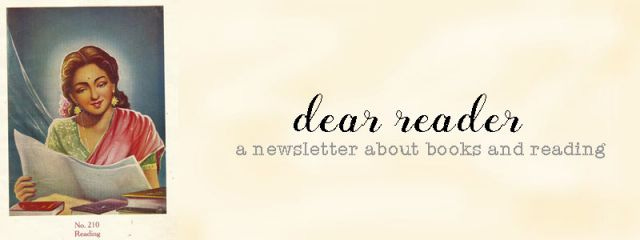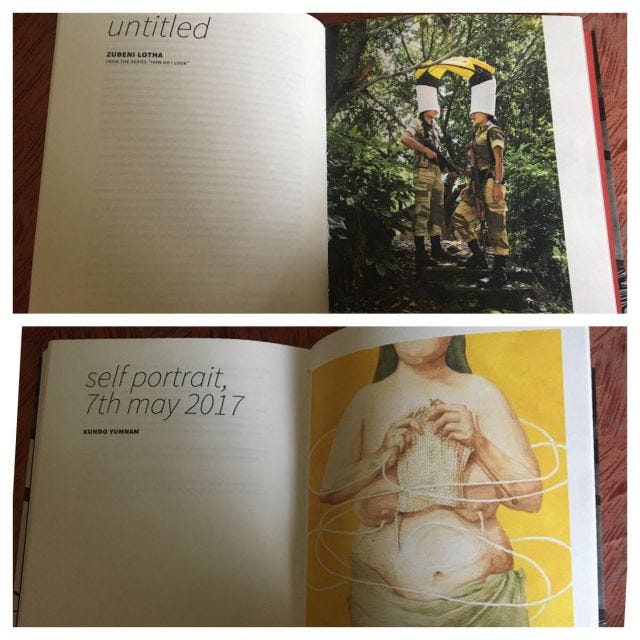Centrepiece + Fire and Fury + The Interpretation of Murder

Kolkata’s boi para, or the neighbourhood of books, is famous. It’s not quite the glorious treasure trove it used to be, with most shops peddling textbooks, but this warren in the city’s north is still a great walkabout if you read Bengali books. The bigger, older shops have gorgeously vintage signage. The buildings are dilapidated, but retain little elegant corners and patches that allow the imagination to glimpse how beautiful these streets must have been once. Books spill out of shops, they are crammed into shelves, they’re used to build piles that are like load-bearing columns. Walk past and every seller (most of them men) will ask you what book you’re looking for. Sure they want to sell, but they also genuinely want to know and if they don’t have what you want, they will happily direct you to the bookseller who will have your title. There isn’t much that I love about this wretched city, but its breezy expectation that you must be a reader and want to consume books by the dozen is one of them.
So this past week, I haven’t read much that’s new except Fire and Fury: Inside the Trump White House by Michael Wolff. I wasn’t intending to read this one, but it showed up as a Whatsapp forward and before I knew it, I was about 200 pages in. This should be a good thing, right? There’s a lot to be said for writing in a way that doesn’t put a reader to sleep, but as I sped through Wolff’s text, the journalist in me started twitching uncomfortably. Because as salacious and readable as it may be, Wolff’s book doesn’t tell you anything you didn’t already guess or know about Trump & co. Most importantly, it’s shabby reporting. The book is a compilation of gossip, quotes that aren’t necessarily on record and claims that haven’t been corroborated. The only reason we believe Wolff is because we already know Trump is … a very stable genius. Plus, if you actually start thinking about some of Wolff’s own reasoning, you’ll find it’s about as hare-brained as Trump’s.
I do love very stable genius though. We should put it on T-shirts.
In short, do not buy Fire and Fury. It has already made enough money and considering the chaos Trump is unleashing upon America, he and the country deserve a better written and reported book. Here’s looking at The Washington Post’s White House reporters.
Closer home, I finished Centrepiece: New Writing and Art from Northeast India, edited by Parismita Singh, who wrote and drew the fantastic graphic novel, The Hotel at the End of the World. I admit I had high expectations of Centrepiece — and why not? It has some amazing contributors and a wonderful storyteller as editor. Visually, this volume is full of treasures and I almost did a happy dance when I saw details from Minam Apang’s series, “War With the Stars”. That was a gorgeous show, fully of massive, inky and intricate works that you could stare at for hours. Singh’s covered an admirable range with her art selections: from contemporary art to documentary photography to illustration and fabric work that’s reminiscent of home-made dolls.
Centrepiece opens with a photograph by Zubeni Lotha. It shows two women, carrying guns and wearing military uniforms and headgear that transforms their heads to those of hornbills. It’s both absurd and menacing as a summary of today’s Naga identity, referencing the misogyny that keeps women out of ‘men’s work’, the history of violence and army occupation in the state, and finally the exotica of its natural beauty.
The last work in Centrepiece is a self-portrait by Manipuri artist Kundo Yumnam. A woman’s bare torso is seen. From her nipples, white skeins come out like milk and swirl around before getting wound into a piece of knitting that the woman is making. The almost nude-body (she has a skirt wrapped around her hips) reminded me of the 12 Manipuri women who stripped outside the Assam Rifles’ building in Imphal to protest the killing and possible rape of a young girl named Thangjam Manorama. In contrast, the knitting is so calm and meditative. There’s a wonderful mix of provocation and domesticity in this image, which becomes particularly poignant because a number of the essays talk about unacknowledged domestic labour.

These are not just powerful images, they also refer to the concerns voiced by writers in the volume. However, even though the subjects of the essays are solidly interesting, the quality of the storytelling and writing is inconsistent. Often, the language is clumsy and the structure is weak — fatal flaws in short pieces which don’t give the writer the space to make too many mistakes. There are too many moments and characters that feel clichéd among the fiction and memoirs, which is again the writer’s failing. Most of the non-fiction entries are written with so little flair that it’s disappointing since the subjects teem with drama, complexity and humanity. Who’d have thought pieces on women hawkers in Shillong and women brewing alcohol would struggle to hold the readers’ attention because they’re so dry? This is deeply frustrating because I have no trouble imagining that the visuals of Centrepiece would make someone pick up the book. Just as I have no trouble imagining someone abandoning the book because the writing wasn't engaging enough.
This is not to say all the writing is meh. Dolly Kikon’s perspective on women in Naga society and the short story “Women’s Literature” by Sanatombi Ningombam are good reads. A couple of the entries seem full of promise but incomplete, like Singh’s own “In the Market” and “Daksare Sketches”, both of which end very abruptly. For all the beauty in the book, Centrepiece didn’t meet my high expectations, but it’s still a volume that I’m happy to have on my bookshelf (and not just because the cover is a detail from one of Apang’s spectacular works).
I chanced upon an old book this week: Jed Rubenfeld’s The Interpretation of Murder. It’s is set in 1909, in New York, where Sigmund Freud is visiting with a few of his followers (one of whom is Carl Jung). When a young heiress is found, naked, tied up, flogged, lacerated and dead, the mayor of New York deputes the coroner and a detective to find the murder discreetly and quickly. Then, the dead body disappears and the killer targets another beautiful heiress, who manages to save herself but is left traumatised. How fortuitous, then, that Freud is in New York and a disciple of his named Stratham Younger can ably play shrink and detective.
Rubenfeld, incidentally, is the husband of Tiger Mom Amy Chua and in his acknowledgements, he says the story was her idea. Once you find out who the chief villain is, I suspect it will take all of your restraint to not channel your inner Freud and wonder about the workings of Chua’s mind.
This is a super fun book, with glorious (and largely-accurate descriptions) of turn-of-the-century New York. Until he has to actually tie everything together and reveal who done it, Rubenfeld is excellent. He has a lot of little storylines and many characters to manage, and he does this skilfully. Littlemore the police detective and Younger, the two heroes of the novel, are wonderful and I wish they’d got to team up a little sooner. I don’t know if Littlemore has a series, but he totally deserves it. There are a number of twists in the tale and not all of them are equally convincing, but The Interpretation of Murder delivers everything a good murder mystery should.
FROM PENGUIN’S JANUARY LIST
Memories of Fire
Ashok Chopra
Fiction
Five childhood friends meet after 54 years and embark upon a journey into the past. This is Chopra’s first novel and is “inspired by true events”. We’re promised “remarkably realistic characters who tackle prejudice, prestige, privilege and even prison head-on”. (Yes, even prison. Amaze.)
Premchand: The Complete Short Stories
Edited by M. Asaduddin
Fiction
Four volumes that collect short stories by one of Hindi’s most celebrated writers. The collection contains some stories that haven’t been published and the annotations promise to be a geek’s delight. I’m not sure about the floral covers that Penguin has chosen for these books, as though Premchand was secretly a botanist. It’s the kind of imagery that makes me think no one involved with the book has actually read Premchand.
Jonahwhale
Ranjit Hoskote
Poetry
A new volume of poetry that recollects different fragments of the past we’ve inherited and travels on waters familiar and new. This volume has a gorgeous, fishy cover. It’s on my wishlist.
Dreamers: How Young Indians Are Changing Their World
Snigdha Poonam
Non-fiction
A portrait of India’s millennials, this book looks at a generation that’s both desperate and ambitious. Everyone who’s read it has loved it, describing it as one of the best books on India. I’m not surprised because Snigdha Poonam is an excellent reporter. Really looking forward to reading this one.
Indian Instincts: Essays on Freedom and Equality in India
Miniya Chatterji
Non-fiction
Are we willingly entrapped in the institutions of our own making? Have these institutions-the government, corporations, religion-become sources of the problem in India, increasing economic inequality? This collection of 15 essays promises to hold up a mirror to what we Indians have become.
The Islamic Connection: South Asia and the Gulf
Edited by Christophe Jaffrelot and Laurence Louer
Non-fiction
South Asian Islam is a distinct from the Islam of the Middle East. Over the last fifty years, pan-Islamic ties have intensified between these two regions. Gathering together some of the best specialists on the subject, this volume investigates the nature and implications of the cultural, spiritual and socio-economic rapprochement between these two Islams.
Dear Reader will be back next week. Thank you for reading.


